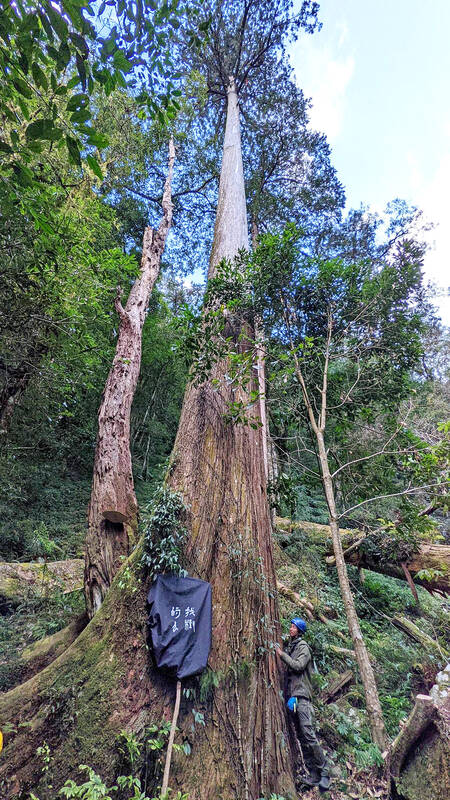A team committed to finding the tallest trees in the nation yesterday said that an 84.1m tall Taiwania cryptomerioides tree had been named the tallest tree in Taiwan and East Asia.
The Taiwan Champion Trees, a team consisting of researchers from the Council of Agriculture’s Taiwan Forestry Research Institute and National Cheng Kung University (NCKU), in June last year used light detection and ranging (LiDAR) imaging to find the giant tree, numbered 55214, upstream of the Daan River (大安溪).
A 20-member expedition team led by Rebecca Hsu (徐嘉君), an assistant researcher at the Taiwan Forestry Research Institute, set out to find the tree on Monday last week, and measured it to be 84.1m tall.

Photo courtesy of Rebecca Hsu
Hsu and Wang Chi- kuei (王驥魁), a professor at NCKU’s Department of Geomatics, initiated the champion trees program, and after analyzing 54,415 LiDAR topographic maps, they identified 941 giant trees that are likely to be more than 65m tall.
Among the tallest trees found by the team, a 79.1m tall Taiwania cryptomerioides tree called the “Taoshan sacred tree” (桃山神木) was found in Shei-pa National Park in 2020, and the 82m tall “Ka’alang giant tree” (卡阿郎巨木), also a Taiwania cryptomerioides, was found upstream of the Ka’alang River (卡阿郎溪) last year.
Tree No. 55214 was estimated to be at least 79m tall through LiDAR imaging, and Hsu believed that it could be the tallest tree in Taiwan based on the shape of the tree trunk and treetop from the LiDAR images.
“Normally, it is difficult for the tree trunk to be visible on the LiDAR images, but the trunk of the No. 55214 tree was clearly presented,” she said.
It is “because the tree is very healthy, and also because there are no other objects nearby blocking it,” Hsu said.
When the team reached tree No. 55214, they found there were several giant trees taller than 60m near it, Hsu said, adding that it stood out from the other trees.
The team only had one day to measure the tree, but it was windy, so the tree climbers had to pause the operation when they were about 8m from the top, Hsu said.
After they finished measuring the tree and found that it was the tallest tree in Taiwan, the team cheered, she added.
The tree’s girth is about 8.5m, which is similar to the “Taoshan sacred tree” and the “Ka’alang giant tree,” Hsu said.
The tree is located in a valley of the leeward side of a mountain, Hsu said.
It is estimated to be about 700 to 800 years old, and there is abundant epiphyte on the tree, she said.
The team has mapped 941 trees that are 65m or taller in Taiwan, and the data can help scientists conduct research on giant trees, Hsu said.

Beijing could eventually see a full amphibious invasion of Taiwan as the only "prudent" way to bring about unification, the US Department of Defense said in a newly released annual report to Congress. The Pentagon's "Annual Report to Congress: Military and Security Developments Involving the People's Republic of China 2025," was in many ways similar to last year’s report but reorganized the analysis of the options China has to take over Taiwan. Generally, according to the report, Chinese leaders view the People's Liberation Army's (PLA) capabilities for a Taiwan campaign as improving, but they remain uncertain about its readiness to successfully seize

Taiwan is getting a day off on Christmas for the first time in 25 years. The change comes after opposition parties passed a law earlier this year to add or restore five public holidays, including Constitution Day, which falls on today, Dec. 25. The day marks the 1947 adoption of the constitution of the Republic of China, as the government in Taipei is formally known. Back then the Chinese Nationalist Party (KMT) governed China from Nanjing. When the KMT, now an opposition party in Taiwan, passed the legislation on holidays, it said that they would help “commemorate the history of national development.” That

HORROR STORIES: One victim recounted not realizing they had been stabbed and seeing people bleeding, while another recalled breaking down in tears after fleeing A man on Friday died after he tried to fight the knife-wielding suspect who went on a stabbing spree near two of Taipei’s busiest metro stations, Taipei Mayor Chiang Wan-an (蔣萬安) said. The 57-year-old man, identified by his family name, Yu (余), encountered the suspect at Exit M7 of Taipei Main Station and immediately tried to stop him, but was fatally wounded and later died, Chiang said, calling the incident “heartbreaking.” Yu’s family would receive at least NT$5 million (US$158,584) in compensation through the Taipei Rapid Transit Corp’s (TRTC) insurance coverage, he said after convening an emergency security response meeting yesterday morning. National

Taiwan has overtaken South Korea this year in per capita income for the first time in 23 years, IMF data showed. Per capita income is a nation’s GDP divided by the total population, used to compare average wealth levels across countries. Taiwan also beat Japan this year on per capita income, after surpassing it for the first time last year, US magazine Newsweek reported yesterday. Across Asia, Taiwan ranked fourth for per capita income at US$37,827 this year due to sustained economic growth, the report said. In the top three spots were Singapore, Macau and Hong Kong, it said. South